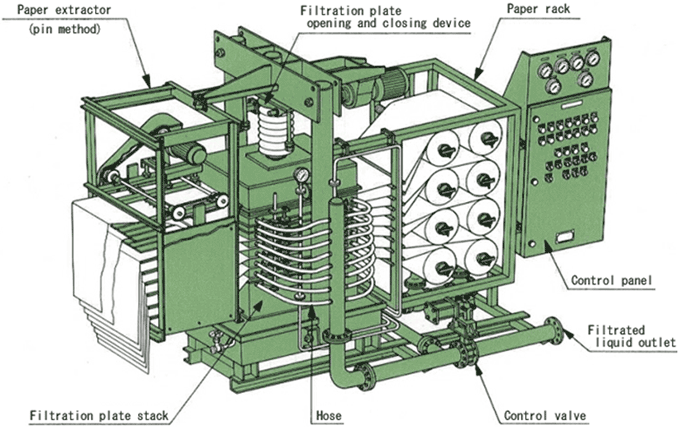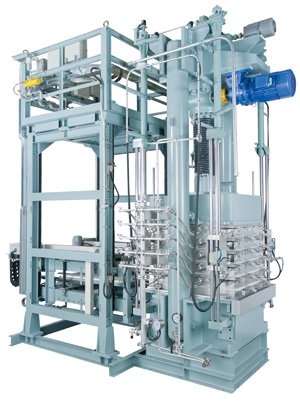- Chemical
- Medicine
- Semiconductors/electronic materials
- Filtration
- Precise separation and extraction
- Recycling
Mitsubishi Schneider Filter
- Chemical
- Medicine
- Semiconductors/electronic materials
- Filtration
- Precise separation and extraction
- Recycling
Mitsubishi Schneider Filter
The Mitsubishi Schneider Filter is a new type of pressurized filter comprising a stack of plates with each plate covered with filter paper or filter cloth. The slurry is fed into filtration chamber of each plate through inlet manifold and hose and then it is filtrated under the pressure given by the mechanical jack mounted on the top of filtering unit. The cake is formed on the surface of filter paper or filter cloth on each filter plate whilst the filtrated liquid is discharged through the hose and manifold of discharge side. Once the filtration cycle is completed the plate stack is opened and the cake is automatically removed.
Forming uniform cake, the horizontal plates allow precision filtering and the Mitsubishi Schneider Filter is used principally to recover clear filtrate. It can also be used for the recovery of the solids from low density slurry and also in the treatment of high viscosity liquids.
The Mitsubishi Schneider Filter is an innovative and labor-saving filter that realizes automatic replacement of the filter paper during filtration, formerly considered a very time consuming process, and as such it lends itself to full-scale factory automation.
Features
The Mitsubishi Schneider Filter offers the following features over conventional pressurized filters using filter paper.
- Automatic filter paper replacement saves labor requirements.
- Ideal for consistent precision filtration because its horizontally arranged plate stack ensures a uniform cake formation.
- Allows uniform pre-coating with a small volume of filter aid like diatom earth or adsorption agent.
- A special sealing mechanism prevents leakage from the filtration plates.
- Suitable for large-volume filtration.
- Independent filtration chamber at each plate (standard filtration area: 1 m2) facilitates cake drying.
- The combination of different types of filter paper and filter aid realizes a wide range of filtration solutions for different applications.
- No need of treatment of remained liquid when operation is over.
- Allows simultaneous filtration of two or more different feed liquids.
- Use of pre-cut filter paper saves running costs.
Specifications
| Filtration area | 0.5 m2/plate , 1 m2/plate |
|---|---|
| Plates/stack | 1 - 25 plates/stack Max. filtration area of 100m2 per one system by using 4 stacks. |
| Throughput | 10 - 200 L/m2/min (depending on the properties of the feed liquid) |
| Filtration performance | 0.2 - 30 μm (depending on filter paper, cloth ) |
| Filtration pressure | 0.4MPa (option) 0.9MPa |
| Plate material | SS400, SUS304, SUS316, polypropylene, rubber lining plate. |
| Hose material | Synthetic rubber, Viton, Teflon, H-NBR |
| Plate heating | Jacket type (area heated is the same as filter surface) |
Structural Drawing

- Filtration plate and stack
Two horizontal square filtration plates are stacked vertically to form the filtration chamber. The number of plates can be increased according to the treatment capacity required. - Filtration plate opening and closing device
A mechanical jack on top of the filtration plate stack raises and lowers the filtration plates when changing the filter paper. - Paper rack
Rolls of filter paper are held in place in the paper rack and fed to individual filtration chambers. - Paper extractor
Filter paper can be changed using either pin or roll methods. In the pin method, the filter paper is impaled by a spike and moved out to be extracted, whereas in the roller method the filter paper is rolled out.
Various automatic filter paper changing methods
- Pin method (standard)
A spike impales filter paper and then filter paper is extracted and replaced over the filtration plate by means of link mechanism. - Roller method
Two rollers are turned to move the filter paper trapped between them. This is well suited to the changing of filter paper when treating high viscosity fluids or when a thick cake with a high solids content is required. A scraper removes the sticky cake from the filter paper. - Pre-cut paper loader and unloader
An automatic arm replaces the filter paper with a little larger square than filtration plate. This method saves space and cuts filter paper consumption by about a third. - Travelling filter cloth change method
When using filter cloth instead of filter paper, this travelling type changer automatically rolls up the filter cloth and washes it, allowing it to be reused. Well-suited to the recovery of solids.
Lineups
| Replacement method |
No. of filtration plates per m2 |
Installation size (L x W x H mm) |
Power requirements (kw) |
Weight (ton) |
|---|---|---|---|---|
| Pin type extractor | 5 | 4025 x 2200 x 2720 | 11.75 | 7 |
| 10 | 4532 x 2200 x 3320 | 11.75 | 9 | |
| 15 | 4595 x 2200 x 4040 | 11.75 | 11 | |
| 20 | 5102 x 2200 x 4766 | 11.75 | 13 | |
| Roller type extractor | 5 | 4310 x 2200 x 2720 | 12.5 | 8 |
| 10 | 5060 x 2200 x 3020 | 12.5 | 10 | |
| Cut paper loading & unloading device |
5 | 4300 x 2200 x 3400 | 14.75 | 9 |
| 10 | 4300 x 2200 x 4980 | 14.75 | 11 |
Main Applications
- Precision filtration of high-viscosity liquid: High-viscosity resin liquid, silicone oil, emulsifier, surfactant, polypropylene glycol, epoxy resin, fluorocarbon resin, fatty acid ester, green tea extract, pigment, agricultural chemical raw material, activated carbon, radioactive waste, organic solvent, strong acid solution, food processing, carbon, grinding water, cleaning solution, pharmaceutical bulk drug and intermediate, cosmetics, and more.
- Filtration of coolant oil for metal rolling: Aluminum sheet, aluminum foil, copper, stainless steel, aluminum and steel can

